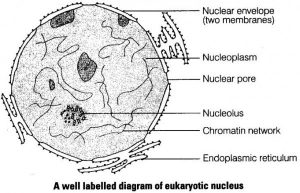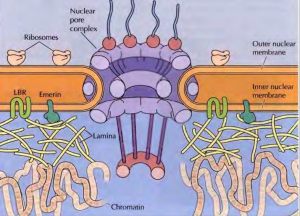Nucleus- Overview
The presence of nucleus is what distinguishes eukaryotic from prokaryotic cells.
The nucleus is known as the cell’s control centre as it carries DNA replication, transcription, and RNA processing with only the final stage of gene expression (translation) localized to the cytoplasm.

It consists of :
1) Nuclear envelope
2) Nuclear pore complex
Nuclear Envelope
- The nuclear envelope separates the contents of the nucleus from the cytoplasm and provides the structural framework of the nucleus.
- There nucleus is double membrane-bounded structure, the inner and the outer membrane
- The two envelope membranes, acting as barriers that prevent the free passage of molecules between the nucleus and the cytoplasm, maintain the nucleus as a distinct biochemical compartment.
- The nuclear envelope has a complex structure consisting of two nuclear membranes, an underlying nuclear lamina, and nuclear pore complexes
- The external nuclear membrane is continuous with the endoplasmic reticulum, which means that the gap between the internal and external nuclear membranes is related directly to the ER lumens.
- There is a presence of nuclear pore complexes, which allow the regulated exchange of molecules between the nucleus and the cytoplasm.
- The outer nuclear membrane has ribosomes attached to the cytoplasmic surface, functionally identical to the membranes of the endoplasmic reticulum.
- In contrast, the inner nuclear membrane contains nucleus-specific proteins, such as those that bind the nuclear lamina.
- The main function of the nuclear envelope involves separating contents from the cytoplasm and nucleus
- The nuclear lamina is present in the inner nuclear membrane which is a fibrous meshwork that provides structural support to the nucleus
- The nuclear lamina also binds to chromatin via H2A, H2B and other chromatin proteins.
Nuclear pore Complex
- The nuclear pore complexes are the only pathways that can move in both the nucleus and cytoplasms, which are small polar molecules, ions and macromolecules (proteins and RNAs).
- ln vertebrates, the nuclear pore complex is composed of 30-50 different pore proteins called nucleoporins
- The nuclear pore complex consists with a montage of a central channel of eight spokes. The spokes are connected to rings on nuclear and cytoplasmic surfaces and are fused between the internal and external nuclear membranes in the spoke-ring assembly in the nuclear envelope
- Protein filaments are constructed from both cytoplasmic and nuclear rings and form a distinct nuclear basket-like arrangement.

References